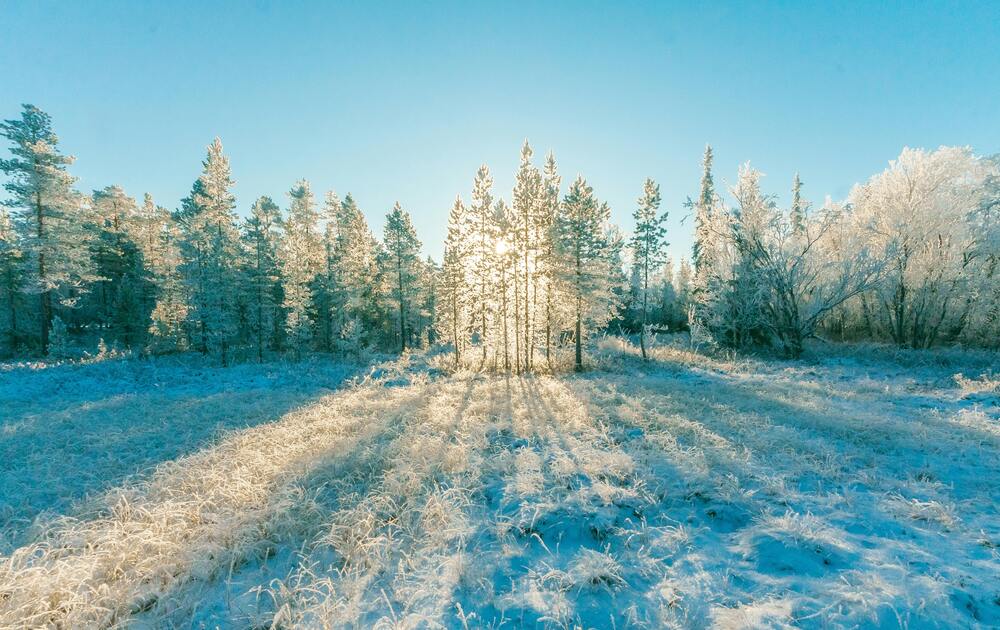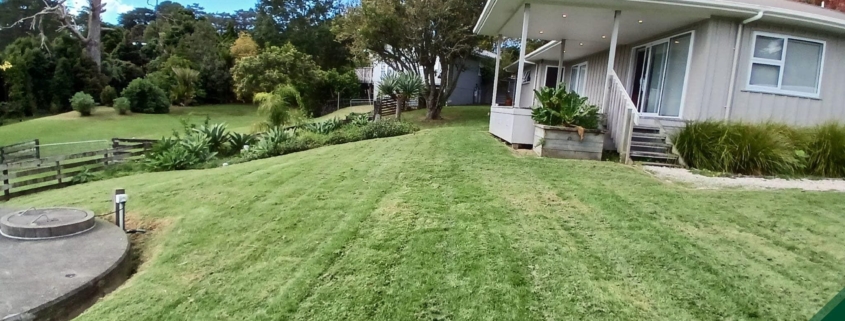How to Shield Your Kiwi Lawn from Winter Chill and Summer Scorch
In New Zealand, we are lucky to have four distinct seasons, each offering its own beauty. However, for your lawn, the shift from a sizzling summer to a chilly, wet winter (and back again) creates a cycle of stress that requires strategic intervention.
Your lawn is primarily made up of two types of grasses:
- Cool-Season Grasses (like Ryegrass, Fescue, and Browntop), which are the dominant species and thrive in temperatures between 15∘C and 24∘C.
- Warm-Season Grasses (like Kikuyu and Couch), which are common in the hotter northern regions, growing best above 25∘C.
Both types require different strategies to survive the Kiwi climate extremes. Here is the Jim’s Mowing NZ guide to protecting your patch across the year.
In this blog you’ll learn:
- Challenges of winter lawn care
- How to protect your lawn from the winter chill
- Challenges of summer lawn care
- How to protect your lawn from the summer heat
The Winter Challenge – Cold, Dormancy, and Disease

Winter in New Zealand, particularly the chill and frost in the South Island and the persistent dampness in the North, presents a significant threat—less from the cold itself and more from the resulting conditions.
Dormancy and Fungal Attack
Most cool-season grasses slow their growth dramatically, but they generally do not go fully dormant unless the temperatures are consistently frosty. Warm-season grasses, conversely, often turn straw-brown and enter full dormancy below 10∘C.
The main winter dangers are:
- Frost Damage – Walking on a frosted lawn shatters the ice-filled grass cells, causing instant browning and severe damage.
- Fungal Diseases – Low light, high humidity, and prolonged moisture on the grass blades create the perfect breeding ground for diseases like Fusarium Patch and Red Thread (as we covered in our previous guide).
- Compaction and Moss – Constant rain and wet soil lead to compaction and waterlogging, allowing moss to take over.
The Protection Plan for Winter
Homeowners must adopt a maintenance-and-prevention mindset during the cooler months:
- Avoid Frost Traffic
This is the most important rule. Keep pets and foot traffic off the lawn until the frost has melted naturally. If you absolutely must melt it, a light hose-off in the morning can help.
- Mow High and Sparingly
Raise the mower height and reduce mowing frequency to only every three to four weeks. Longer grass blades maximise the leaf surface area for catching sunlight, which is vital for survival. Collect the clippings to remove moisture and debris that breed fungus.
- Improve Drainage and Aeration
Before the peak winter wet, aerate your lawn heavily in autumn. This encourages water to penetrate the soil rather than pooling on the surface, which suffocates roots and encourages moss.
- Clear Leaves and Debris
Rake up fallen leaves, which smother the lawn, block vital light, and trap moisture, inviting fungal growth.
- Apply Moss Control
Late winter/early spring is the ideal time to apply a moss killer to prepare the soil for healthy spring growth.
The Summer Challenge – Heat, Drought, and Water Restrictions

New Zealand summers—especially in the North Island and East Coast regions—can be punishingly hot and dry. The biggest threat to your lawn is dehydration and the resulting stress.
The Threat – Dehydration and Stress
Cool-season grasses (like Ryegrass and Fescue) are particularly vulnerable to dry conditions. When water is scarce, they enter a stress-induced dormancy, turning brown to conserve resources. This state makes them highly susceptible to pest infestation (like Grass Grub) and disease (like Dollar Spot).
The main summer dangers are:
- Drought Stress – Lack of water causes the lawn to stop growing and brown off rapidly.
- Mowing Too Low: – Short grass offers no shade to the soil, causing the ground to heat up, dry out faster, and stress the roots.
- Pests – The hot, dry conditions are often when pests like Grass Grub and Porina Caterpillar do their worst damage, as the turf is too weak to fight back.
The Protection Plan for Summer
The focus shifts to water conservation and providing shade for the root zone:
- Water Deeply in the Morning
As covered in the disease guide, water only in the early morning to prevent immediate evaporation and overnight fungus. Water for a long period (30-45 minutes per zone) once or twice a week, rather than daily, shallow sprinklings. Deep watering encourages the grass roots to grow deeper, making them more resilient to drought.
- Raise the Mower Height
This is non-negotiable in summer. Set your blades to the highest setting. The longer blades shade the soil, keeping the roots cooler and reducing water evaporation by up to 30%.
- Apply a Wetting Agent
Before summer hits, apply a quality soil wetting agent. This is crucial for Kiwi soils, especially where water repellent hydrophobic areas form. The wetting agent breaks the waxy barrier on the soil surface, allowing water to penetrate to the roots instead of running off.
- Reduce Foot Traffic
During periods of extreme heat or drought, minimise walking on the lawn. Grass under stress is brittle, and traffic can break the crowns, leading to bare patches.
- Feed with a Stress Reducer
Use a specialised summer fertiliser or an application of liquid seaweed. Seaweed helps strengthen the grass cells and root system, increasing the lawn’s tolerance to heat stress and drought.
Conclusion – A Year-Round Strategy is the Only Way
In New Zealand, the battle for a beautiful lawn is truly a year-round commitment. It’s not enough to simply mow in spring; you must proactively protect your turf against the seasonal extremes.
The homeowner’s role is to ensure the soil is healthy, well-draining, and nutrient-rich, preparing the grass to withstand the inevitable summer scorch and winter wet. By adjusting your watering, mowing, and feeding practices in anticipation of the weather, you remove the primary stress factors that allow diseases and pests to gain a foothold.
If you want the best lawn on the street, let the experts handle the heavy lifting. The Jim’s Mowing NZ team can assess your specific grass type and regional climate to develop a tailored, year-round maintenance plan that guarantees a lush, green, and resilient turf, regardless of the season.
Frequently Asked Questions (FAQ) About Lawn Diseases and Climate Care
Diagnosis and Treatment
Q1: What is the most common sign of a fungal lawn disease in New Zealand?
The most common signs are patches of discoloured grass (yellow, brown, or straw-coloured) and the presence of fine, thread-like structures on the grass blades in the early morning dew. The appearance of small, reddish-pink threads (Red Thread) or small, bleached spots (Dollar Spot) are specific indicators.
Q2: Is it better to use a fungicide or try cultural practices first?
It is always recommended to try cultural practices first. Correcting your mowing, watering, and fertilisation routines can often eliminate the conditions the fungus needs to survive. Fungicides should be considered a last resort for severe or persistent infections.
Q3: What is the one crucial thing I must change about my watering to prevent disease?
Water only in the early morning (before 10 am). This ensures the grass blades have the entire day to dry out completely. Leaving foliage wet overnight creates the perfect environment for fungal spores to germinate and spread.
Q4: If I have a lawn disease, should I collect my grass clippings?
Yes. If you have an active fungal infection, you should use a catcher and remove the clippings. This helps to physically remove the fungal spores from the lawn, preventing them from being spread by the mower across the healthy turf.
Climate Protection
Q5: Do most New Zealand lawns go dormant in winter?
Cool-season grasses (Ryegrass, Fescue, etc.), which are dominant in NZ, slow down significantly but usually remain active and green in milder regions. Warm-season grasses (Kikuyu, Couch) will turn brown and go fully dormant once temperatures consistently drop below about 10∘C.
Q6: How do I protect my lawn from summer heat and drought?
The best defence is mowing high and watering deep and infrequently.
- Mow High – Set your mower to the highest setting to allow longer blades to shade the soil and keep roots cool.
- Water Deeply – Water for long periods (e.g., 30-45 minutes) once or twice a week to encourage deep root growth, making the grass more drought-tolerant.
Q7: Why is walking on a frosty lawn a problem?
Walking on a frosted lawn is disastrous because the frozen water inside the grass cells shatters under pressure. This crushes the grass blades and permanently damages the plant tissue, resulting in visible brown footprints or patches that won’t recover until the next growing season.
Q8: Should I fertilise my lawn in summer?
It is best to apply your main feeds in spring and autumn. Applying a high-nitrogen fertiliser during peak summer heat can stress the grass. If your lawn is struggling in summer, opt for a light application of liquid seaweed or a stress-relieving tonic to boost root health instead.




